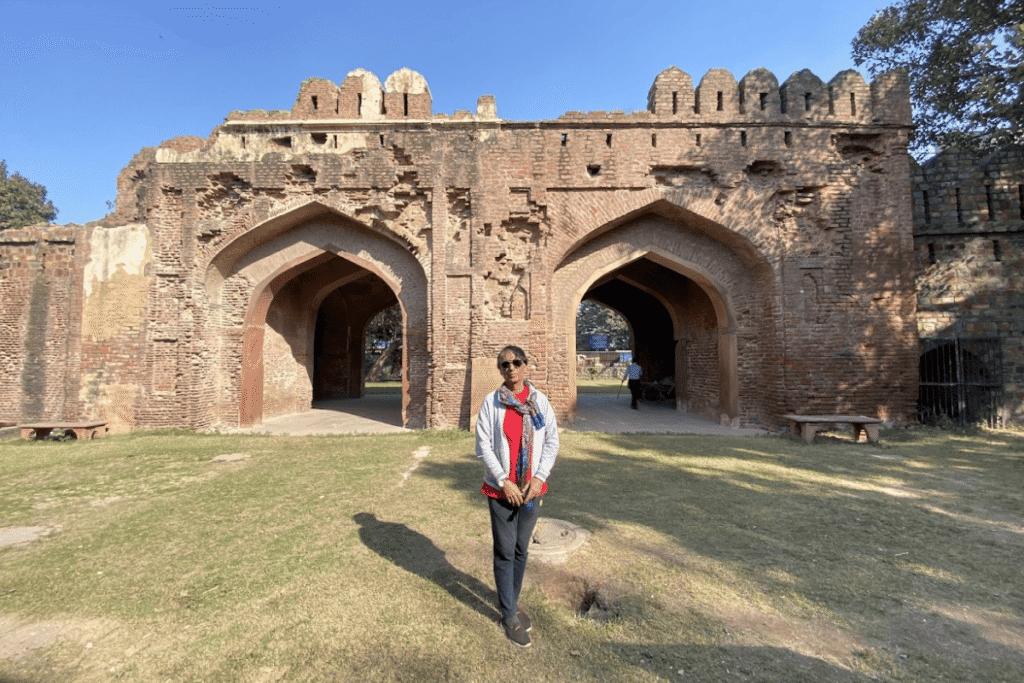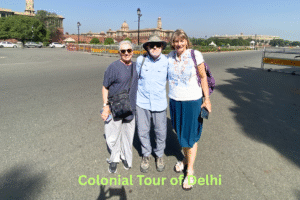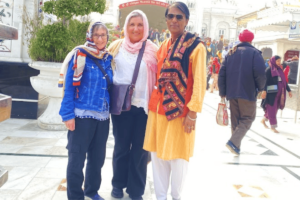Exploring the Kashmiri Gate Delhi history is like stepping into the pages of a forgotten era. On my Old Delhi Heritage Walk with Harry, our local tour guide, I discovered that this iconic gate isn’t just a structure—it’s a silent storyteller of battles, trade, and changing empires.

Kashmiri Gate Delhi History Tour With My Delhi Guide
I came from Australia with my husband and stayed in a cozy hotel in North Delhi. With a free morning before joining our tour group the next day, I sipped my coffee and browsed my phone for Old Delhi heritage tours. That’s when I stumbled upon Harry — a local tour companion in Delhi. His walking heritage tours looked different — personal, authentic, and rich with stories. I sent him a WhatsApp message, and within minutes, he replied with details of a heritage walk starting near my hotel. Done deal.
The next morning, we met Harry in the hotel lobby — young, cheerful, and already sharing snippets of Delhi’s past before we even stepped outside. His passion for the city was contagious, and he seemed to know every twist and turn of the old streets like an old friend. Our first stop, just across the road from ISBT, was the historic Kashmiri Gate which was built in 1639 CE, once a grand entry point to Shahjahanabad, capital of Mughal empire , now quietly holding centuries of history in its weathered stones. Kashmiri Gate is a popular landmark in Delhi, connecting several major roads and serving as a hub for the city’s transportation network.
Experience Old Delhi Heritage Tour with Best Guide
Kashmiri Gate Delhi The Historical Significance
The Kashmiri Gate Delhi history is evident in its distinctive architectural features. The Kashmiri Gate in Delhi was originally part of the northern wall of Shahjahanabad, designed to impress and defend simultaneously. Its double-door design, rare in Indo-Islamic and Turko-Afghani architecture, allowed separate entry and exit for travelers and traders. The massive wooden doors, arched openings, and ornamental details reflect the Mughal emphasis on strength and elegance. A moat once added an extra layer of defense. Later, in 1835, the British Military Engineer Robert Smith rebuilt and modified the Kashmiri Gate in Delhi, merging Mughal craftsmanship with colonial structural sensibilities. Walking through its archways today, one can clearly see why the Kashmiri Gate Delhi history is celebrated as a remarkable example of defensive architecture and design fusion.

Kashmiri Gate Delhi History A Witness to the Revolt of 1857
In the Kashmiri Gate Delhi history, the events of September 14, 1857, hold special significance. On that day, British troops launched a massive assault to recapture Delhi from the rebels. The Kashmiri Gate became the main point of attack, as it was strategically located and provided a direct route into the city. The British forces used explosives to breach the gate’s walls, leading to a brutal confrontation. The defenders fought valiantly, but the sheer force of the attack eventually overwhelmed them, marking a turning point in the siege of Delhi.
Today, Kashmiri Gate is not just a traffic hub but a place of heritage, where history whispers through every brick. Visitors can still see the bullet marks and damaged portions of the gate, preserved as a tribute to the courage and sacrifice of those who fought here. The Kashmiri Gate Delhi history is not merely a chapter in textbooks—it is an emotional reminder of the resilience of the people and the enduring spirit of resistance that shaped India’s struggle for independence.
Read More at Wikipedia : The Sepoy Mutiny-Indian Rebellion of 1857
Kashmiri Gate Delhi An Architectural Charm and Mughal Legacy
The Kashmiri Gate Delhi history is deeply rooted in its architectural brilliance. The Kashmiri Gate in Delhi was originally one of the key entrances to the walled city of Shahjahanabad, located in the northern part of the city. Its double-door design, featuring separate entry and exit points, was unusual for Indo-Islamic and Turko-Afghani styles. Harry explained how the massive arched openings and sturdy wooden doors were both defensive features and symbols of Mughal authority. A moat once added extra protection, emphasizing the strategic importance of the gate. Later, in 1835, the gate was redesigned and reinforced by British Military Engineer Robert Smith, blending colonial techniques with Mughal architecture, making the Kashmiri Gate in Delhi a unique testament to centuries of evolving architectural styles.
Kashmiri Gate Delhi The Life Around Kashmiri Gate Today
While the Kashmiri Gate Delhi history speaks of wars and emperors, the surrounding area today is a lively mix of old and new. Harry led me to St. James’ Church nearby—a colonial-era gem built by James Skinner in 1836. He also showed me the bustling market lanes where the aroma of kebabs mingles with the chatter of shopkeepers, hinting at Old Delhi’s timeless charm.







